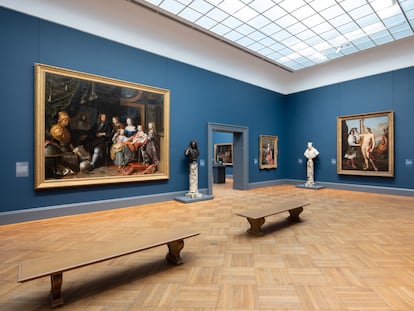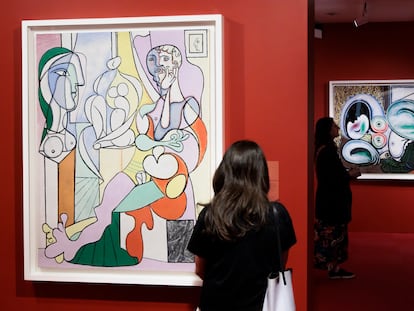Picasso passes the baton to Dalí
2024 will mark 120 years since the birth of the Catalan artist Dalí, perhaps making it an optimal moment to rethink his extraordinary timelessness
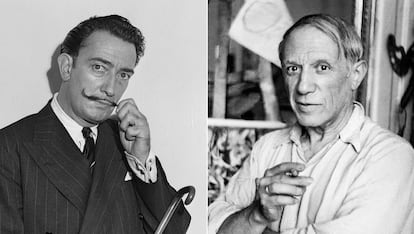
Recently I asked a person with strong ties to the 50th anniversary of Picasso’s death — 2023 was filled to the brim with related events — what new perspectives had been introduced by the yearlong celebration. They didn’t hesitate: it had reinforced Picasso’s link to Spain by underscoring his lesser-known ties to the country’s everyday life, from A Coruña to strolls down the Prado Museum. The answer led me to reflect. Picasso, despite having garnered little sympathy from the Francoist authorities, has been one of the greatest representatives of “Spanishness.” Gertrude Stein spoke in 1938 of an “orientalist” Picasso, one who embodies the well-known Spanish temperament, that which had fascinated French writers and artists since before Manet. In other words, Picasso was “exotic,” ma non troppo, similar to the Spain constructed by the country’s Royal Tourist Board in the campaigns it displayed in France in 1929: “The comfort of Europe / the exuberance of Africa / await you in Spain.”
That combination has haunted the clichéd image of the “Spanish Picasso.” From bullfighting to passion, as emphasized in the long profile on the artist, forever associated with Spanish art and poetry, in Life magazine in 1968, Picasso has embodied a certain yearning expressed at the reopening of Paris’s Picasso Museum in 2015 by the then-president of the French republic, François Hollande: “Pablo Picasso, the Spaniard, the republican, the communist, is the pride of France.” And yet, France was late in reclaiming Picasso, reflected Annie Cohen-Solal in Picasso the Foreigner (2023). The text — one of the most novel works on the artist, along with Mercedes Guillén’s Spanish language Picasso con los exiliados [Picasso with the exiled] (2023) — documents the artist’s difficulties being accepted in France. Persecuted as an anarchist, excluded from public collections for decades, with various failed attempts at getting his French citizenship… Cohen-Solal’s Picasso supports the thesis of John Berger’s dazzling The Success and Failure of Picasso (1965): upon his arrival in Paris, the Malaga-born artist was as much of an outcast foreigner as his circus characters or the bohemians in his print The Frugal Meal.
Despite it all, one could argue that in Spain, Picasso is perceived as “very French,” a New Wave character in his sailor suit that Chanel made fashionable. What is interesting is Picasso’s handling of these ambivalences, his deliberate adoption of each stereotype into his persona, which, just like his work, is plagued by mixtures and erasures. In this sense, the numerous photographs for which Picasso posed throughout his life are eloquent. Through them, the idea of an artist self-absorbed in creation, disdainful of his public image, the one that canonical narrative places in opposition to that of Dalí — and not only due to their political ideals — is broken. Dalí is the celebrity and Picasso the creator; Dalí is the character and Picasso the artist without fissure. Here, defenders of Picasso despise those of Dalí, appealing to the perfect excuse: Picasso was a republican hero and Dalí a mundane conservative, fascinated by money and fame.
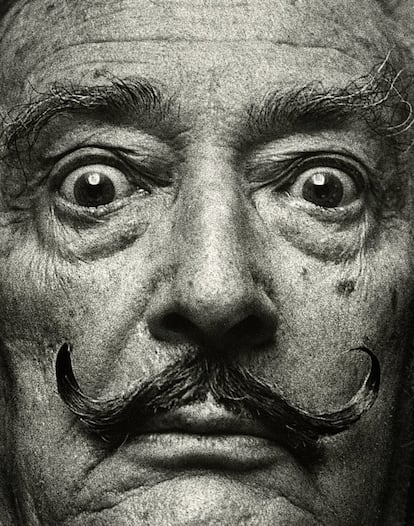
However, this polarization — that buzzword — is another kind of scenography, and perhaps both artists share more than what canonical history — as interpreted by either faction — would have us believe. Both, excellent painters and performers, were media personalities by choice, given that the one who poses before the camera controls the narrative. This aspect has perhaps been missing from the numerous exhibitions from 2023′s Año Picasso: an in-depth look at the performer Picasso that reveals his relationship with the power of images and the mass media; an Instagrammer Picasso that would exhibit his interest in the construction of the “Picasso character,” similar to that of Dalí despite appearances, although often denied in order to give prominence to the conventional image of the great master that suits the canonical discourse. A pity, because it would have offered a contemporary re-reading of this artist, who has been put in dialogue with the old masters, has been confronted with living artists to varying degrees of success, and has been related to his friends, Stein in Paris, a marvelous exhibition, or Kahnweiler in Barcelona.
In this era of cancellations, Me Too and the LGBTQI+ community, we have become entangled more than anything in Picasso’s relationship with gender — It’s Pablo-matic, at the Brooklyn Museum — and even in his homosexual overtones, subtly suggested by endorsed by Von Gloeden’s photographs in the beautiful exhibition Picasso 1906, at Madrid’s Reina Sofia. Or maybe Año Picasso, the collaborative public project between France and Spain, has bet first of all on the great artist Picasso to settle the historical debt that both countries, it seems, had with him for different reasons. In this catharsis, there was no place for the performative.
But if Año Picasso came to an end at the stroke of midnight, Picasso has passed the baton over to Dalí for the 120th anniversary of the 1904 birth of the Catalan artist. A Picassoian told me that the score is not even and it will not be the two countries’ catharsis for obvious reasons, but there will certainly be revisions, and I wonder what they will be, in addition to the old political reproaches. It will be interesting to rethink Dalí from the Me Too and LGBTQI+ perspectives, which have permeated so many conversations about Picasso, for on this point the Catalan’s resume is impeccable, between García Lorca, the androgynous Amanda Lear and his great love, Gala, whom he not only painted. He shared with her authorship in “his best works,” building the queerest caper, a certain liquid identity in a signature signed by a single person: Gala Salvador Dalí. Moreover, in this same vein, Dalí himself announced that in the future, things would never be the same.
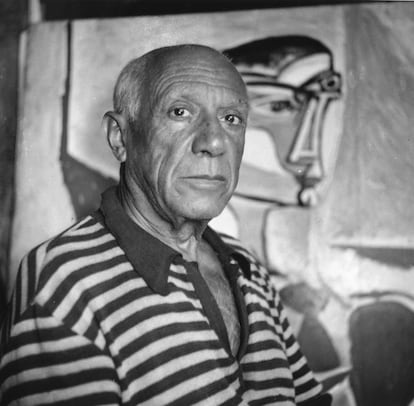
Perhaps his fascination with the future is what led him to become interested so early on in DNA. I remember seeing him on television in my childhood, when there was only one channel, with his mustache, talking about molecular structures. Most people took him for a joke: another artistic eccentricity. In that black and white Spain, Dalí was talking about the future, and I wonder now if it was his form of rebellion against the established. In matters relating to science, Dalí was well ahead of television viewers, including Picasso, almost certainly.
As a preview of the celebration, the Gala Salvador Dalí Foundation has invited from Scotland Dalí's well-known Christ, painted in 1951. The exhibition, which presents the process of execution of the work, reproduces the scenography devised by Dalí himself, and the lighting gives new perspective on the impressive painting as seen from the present, the 120th anniversary. What if the painting was much more than a religious image? Between Christ and Cap de Creus, which was a recurring landscape for the painter, an amalgam of apparent clouds reinforces the separation between heaven and earth. But no, they are not clouds. They are somewhat reminiscent of the first images of our planet taken from outer space in the late 1940s and published in the early 1950s. Suddenly, the perspective of the painting reveals a premonition of the world as seen from outside: the well-known image of the Earth from the Moon, published years later.
If it’s true that the Año Picasso has served us in speaking of gender and returning Picasso to the Spanish everyday — among other things — perhaps the commemoration of Dalí will serve to rethink his extraordinary timelessness: how in that television interview, he was talking about something fundamental that he had intuited before anyone else, that would later fill the conversation and work of so many artists. Those who are of the now: the passion for science.
Sign up for our weekly newsletter to get more English-language news coverage from EL PAÍS USA Edition
Tu suscripción se está usando en otro dispositivo
¿Quieres añadir otro usuario a tu suscripción?
Si continúas leyendo en este dispositivo, no se podrá leer en el otro.
FlechaTu suscripción se está usando en otro dispositivo y solo puedes acceder a EL PAÍS desde un dispositivo a la vez.
Si quieres compartir tu cuenta, cambia tu suscripción a la modalidad Premium, así podrás añadir otro usuario. Cada uno accederá con su propia cuenta de email, lo que os permitirá personalizar vuestra experiencia en EL PAÍS.
¿Tienes una suscripción de empresa? Accede aquí para contratar más cuentas.
En el caso de no saber quién está usando tu cuenta, te recomendamos cambiar tu contraseña aquí.
Si decides continuar compartiendo tu cuenta, este mensaje se mostrará en tu dispositivo y en el de la otra persona que está usando tu cuenta de forma indefinida, afectando a tu experiencia de lectura. Puedes consultar aquí los términos y condiciones de la suscripción digital.
More information
Archived In
Últimas noticias
The complicated life of Francesca Albanese: A rising figure in Italy but barred from every bank by Trump’s sanctions
How Japan is trying to avert ‘digital defeat’
Half of Scotland is in the hands of 420 property owners
Reinhard Genzel, Nobel laureate in physics: ‘One-minute videos will never give you the truth’
Most viewed
- Pablo Escobar’s hippos: A serious environmental problem, 40 years on
- Why we lost the habit of sleeping in two segments and how that changed our sense of time
- Charles Dubouloz, mountaineering star, retires at 36 with a farewell tour inspired by Walter Bonatti
- Reinhard Genzel, Nobel laureate in physics: ‘One-minute videos will never give you the truth’
- The Florida Keys tourist paradise is besieged by immigration agents: ‘We’ve never seen anything like this’

